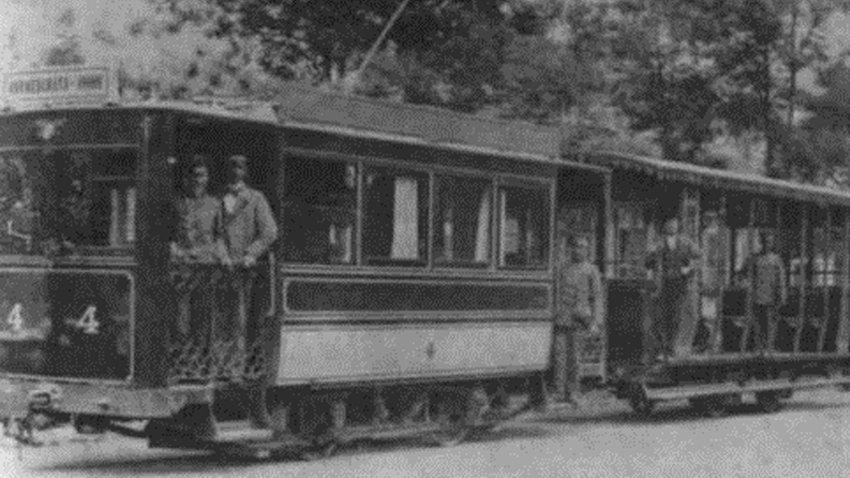Electric lights in the streets and in homes illuminated the start of the 20th century of the then young capital of Bulgaria – Sofia. But the new century also saw another groundbreaking event – the first tram.
To use the word “wonder” for the good old tram may sound ironic in the high-tech world of today. But it should be noted that Sofia (until 1878 regional centre within the bounds of the Ottoman Empire) was running behind many of the major Western cities of the time. For example, Sofia started running on electricity in 1900, 18 years after Thomas Edison electrified part of New York. The swift development of Bulgaria is a benefit that came with its democratic revolution – because the country’s liberation from Ottoman domination in 1878 was just that.
Yesterday the people of Sofia witnessed a new phenomenon of universal progress – the first tram cut through almost the entirety of Vitoshka Street (the central Sofia boulevard Vitosha of today). That was how a newspaper from the turn of the 20th century described the technological miracle that made its appearance on 1 January, 1901. The first tramcar ran from the railway station to the centre of the city, stopping along the way as passengers signaled. Tickets cost the price of a bottle of beer. The compartments were divided into first and second class – the Sofia elite travelled surrounded by drapery and window and seat decorations, while the populace sat on wooden benches.
“At the beginning people looked on trams in awe – all of a sudden there was a means of transportation that ran on electricity instead of being drawn by animals,” says Victor Chaushev from the Urban Transport and Infrastructure association. “To begin with people were even afraid to get on the tram, they would stand around and wait for someone else to get on first. While writer Ivan Vazov described how the rich gave children from poorer families pennies to take a tram trip and see if it was safe.”

We owe the appearance of trams to Mayor Dimitar Petkov who, during his term of office /1888-1893/ was at the basis of the first plans to bring electricity to the city and of the first concessions. Later (after 1898) the Belgian company “Electric trams” built 25 kilometres of single-track tram rails in two years.
“The interesting thing is that concessions, then as now, were the subject of heated debate at the city council, all the more so that in this particular case there were many candidates, and, naturally, lobbyists,” Victor Chaushev says. “The state archives provide evidence about the concession process, interesting statements made, accusations of lobbying and corruption. Ultimately it all ended well because the result was made visible very quickly and thanks to trams, Sofia was beginning to look like a genuine European capital.”
Construction of Bulgarian trams started in the 1930s using the trams imported from Germany as a model. The best designs appeared after World War 2, and later new tram designs were introduced, though technologically, they were far behind the top achievements in the world, says Victor Chaushev. We no longer make trams, we import all trams – different in quality, model, colour.
“It is a matter of perception,” comments Victor Chaushev. “The trouble is that no efforts are being made to make trams uniform – in terms of design and colour – so as to reduce the harmful visual effect on the urban environment. On the other hand, the fact there are so many tramcars means that in time we shall have a fleet of historical tramcars. If we have a transport museum that is interesting that would lend added value to the tourist service Sofia has to offer.”
A museum would in fact house the historical pieces now crumbling to pieces at tram depots. But though trams have been part of the urban landscape for one century they still have a role to play.
“The trouble is that this is a service that has not been modernized,” says Victor Chaushev further. “Trams can transport almost as many passengers as the underground along tramway lines, and that is something that can be seen in the Czech Republic and in Germany. There are many places in Sofia where tramway transport should be developed and people should get a cheaper kind of transport service. Instead of building the underground, trams will increase considerably the number of passengers in urban transport and ease traffic in the city significantly because there is no way the underground can reach all parts of the city.”
Diana Tsankova
The film "Gundi: Legend of Love" caused a sensation across the Ocean. Screenings of the film story about the life of legendary football player Georgi Asparuhov – Gundi were held in Los Angeles and Las Vegas as the halls were full...
On this day 35 years ago, the authoritarian regime of communist dictator Todor Zhivkov collapsed. To mark the anniversary, the BGNES news agency carried out a survey of monuments to totalitarianism. The agency checked whether the monuments of the..
Residents and guests of the village of Kolena, Stara Zagora Municipality, gather for the Young Wine Festival. The event was celebrated for the first time in 2017, and a few years later the local teacher and winemaker Martin Slavov gave the..
Modernizing critical thinking skills, fact-checking skills and media literacy are essential for society, especially for young people in Bulgaria - the..
"You say you are Bulgarian, but you do not know Bulgarian" – this reproach from officials in Bulgaria has been faced by quite a few by our compatriots..
The survival of millions of people around the world, living in conditions of war, hunger, disease and immense despair, is at stake every day. We often..

+359 2 9336 661
